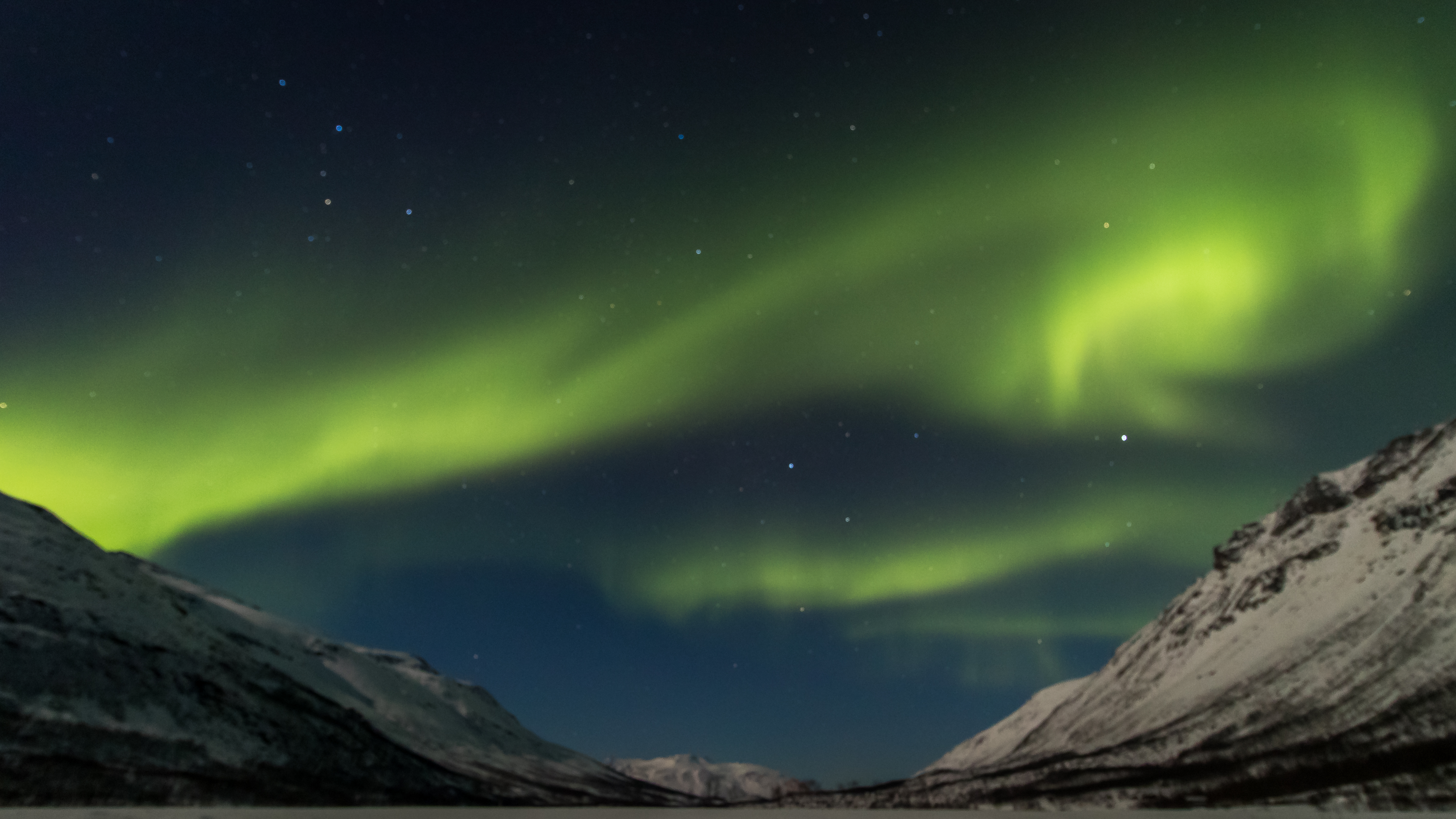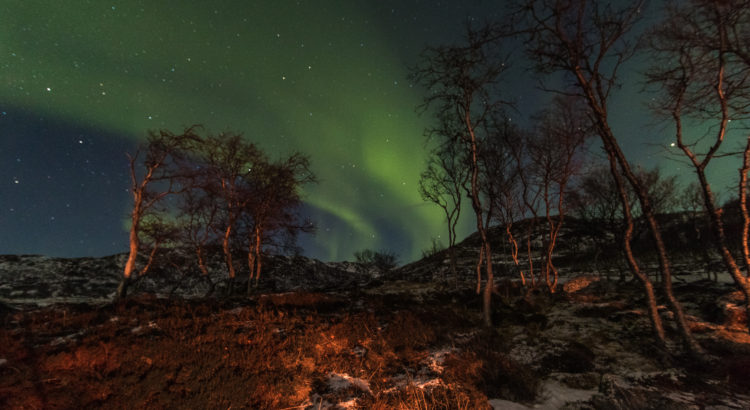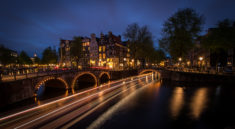I have never before felt a temperature below zero degrees Fahrenheit until I stepped out unto a frozen lake bed north of Tromsø. The temperature on my phone read -22 degrees Celsius[i] and my mental math shut down in the attempt to convert that to a temperature I could actually understand[ii]. The biting chill of the wind on my face was enough to make the point it was cold. Looking up in the sky, I tried to find the north star. I’m used to looking for the big dipper somewhere above the horizon, then tracing my way to the little dipper and then the north star. I couldn’t find it at first, having to look almost straight up till I finally reached it. That’s how you know you are in the arctic circle. You are looking straight up at the north star.

When I first saw the northern lights, I had no idea that I was in fact looking right at them. Our guide pointed on the horizon and said, “Look right there.” In the distance, there was simply a green fog high in the sky. I took a picture of it and saw a deep green streak appear on the display of my camera. I was in some ways disappointed to think that I had arrived and that this was it. The northern lights were a camera trick. A camera and the human eye see light very differently. With a long exposure anywhere between 15 and 25 seconds, the camera can capture more light than the human eye. As a result, the aura that I saw with my eye would appear as a brilliant emerald paint strokes across the sky on the camera display. I was mixed with a sense of disappointment but still a sense of wonder of what I was seeing. The haze swirled slightly and moved gently on the horizon as if the sun was in the very last stages of a sunset shaded green. The group I was with sat watching the stars and enjoying our surroundings. We built a fire off the edge of the lake and huddled around for warmth, talking amongst one another. There was a family from Italy, a couple from Germany, and two sisters from the UK. We had very little in common except our desire to see the northern lights. After awhile, we had some soup to warm ourselves up as best we could, and as we were about to eat, the valley turned a faint shade of green as the sky reflected off the snow. We looked up and found ourselves surrounded by dancing tendrils of brilliant green light in the sky.

To fully appreciate the northern lights, it is important to understand the phenomena that causes them. The sun periodically ejects charged atoms towards the earth called solar wind which then strikes the earth’s atmosphere. These particles then react with the elements in the earth’s atmosphere which appear as bursts of light. While the lights are most often green, they can also produce red and violet colors from particularly powerful solar storms. While the northern lights are associated with the winter months, there is activity throughout the year. However in places as far north as Tromsø, the summer holds periods called midnight sun where the sun never truly goes down in the sky. Therefore it is never dark enough to see them. In the months of December and January, Tromsø is shrouded in what is called polar night, when the sun does not rise. The local guide described that all they see for several months is a light blue hue on the horizon around noon before it grows dark once again. However, it is in these months where it is most advantageous to see the northern lights. As the northern lights are dependent on solar activity which can be hard to predict, it is most important to have clear skies and dark nights to give yourself the best chance of seeing them. Tromsø from November to March is therefore a great place to go to maximize your chance of seeing the lights.

Tromsø itself is one of the largest cities in the arctic circle. For those wishing to see the northern lights, this is an ideal place to start your trip as it has an airport with several inbound and outbound flights every day, and it puts you just about as far north as you can go in Scandinavia. There are other smaller cities in Norway, Finland and Sweden that could be considered farther north, however I found it rather expensive to fly into those airports by comparison. This is not to say you shouldn’t go somewhere other than Tromsø on your trip to see the lights, but Tromsø is a good place to start as these other cities are a short flight away. The city itself is very quaint with a main street that can be walked in around 25 minutes. There are several restaurants and shops, along with a few museums for those of different tastes. Polaria offers visitors the chance to learn more about the Svalbard region and its native wildlife. The Polar Museum offers a realistic view[iii] on life in the Arctic Circle. The Museum also chronicles the lives of the polar adventurers and their attempts to reach the north pole, which spoiler alter was a fairly dangerous job[iv].

But the main attraction of this area is of course the aurora borealis. There are several ways to see them, but I personally recommend finding a tour company. I’m someone who prefers a great deal of freedom and sense of adventure when I travel. I usually want to book my own transportation, plot my own journey, and set my own itinerary. However, when the weather forecast reads -22 (doesn’t matter Fahrenheit or Celsius at that point frankly), you need to be smart about how you travel. With a tour company, you get a driver with experience in those conditions and someone who knows the area and can find the best spots to go for clear skies and an idyllic backdrop. I had a great two night trip with Artic Explorers which not only provided transportation but also thermal gear and boots which probably saved at least a few of my digits on my second night. They also help build a fire for the group and bring hot food and drinks which you will be incredibly thankful for. In total, I felt finding a tour company in this case was worth the investment as it provided some ease of mind, a lot of extra comfort, and an overall great experience. The guides are also good photographers who understand how to capture the lights, which for those unfamiliar with night photography can be challenging. I would like to do a longer and more detailed post on this topic, but for those going for photography you will need a tripod (which some tour companies may provide) and a camera with the option to use manual settings.

Personally, I have a Canon 80D and I mainly used a wide-angle lens (Canon 10-18mm, 4.5). I would recommend a wide-angle lens to capture more of the sky, but obviously with a wider aperture to allow in more light. With a wider aperture, your camera will be able to use faster shutter speeds and lower ISO levels to get better quality images. With my lens, I was required to use an ISO between 1200 and 1600 with shutter speeds between 15 and 25 seconds to get the correct exposure. A better lens would offer a lot more flexibility in your choices and it would probably yield better results. But with that said, my camera and lens combination yielded some great photos on their own.
I was incredibly fortunate to see the lights on both of the nights I went out. The best you can do is try to plan your trip around a period with a good weather forecast. The longer you stay the better your chance of seeing them. Was it worth it? Not for the photography, but for someone who just wants to witness it? Was it worth it just standing in the snow, looking up at the sky, and seeing something truly unique. I would have to say it absolutely was. Even understanding what you’re seeing and why this is occurring, you can’t help but feel a sense of wonder. I wanted to know what the first person who saw this must have thought. I could imagine those explorers, trekking their way into the unknown, looking up at the sky and seeing these lights as beacons of hope. It seemed that even in the freezing cold, that feeling of chill dissipated as you just look up and watch. If you go, I hope you see them. But more importantly I hope you step back from the camera lens and appreciate them just as they are.

[i] Now having lived abroad for some time, I’m on board for a universal system of measurement. I don’t care if its feet, miles, kilometers, Fahrenheit, Celsius, kelvin, kilograms, pounds, or stones let’s just all get on the same system please.
[ii] I would have used my phone but it practically died immediately from the cold.
[iii] When I say realistic, I actually mean highly realistic. There is an exhibit on how hunters used to kill seals which is definitely not for everyone.
[iv] Mad respect but I think I would have bailed on this project after the first ten guys before me just never came back.




